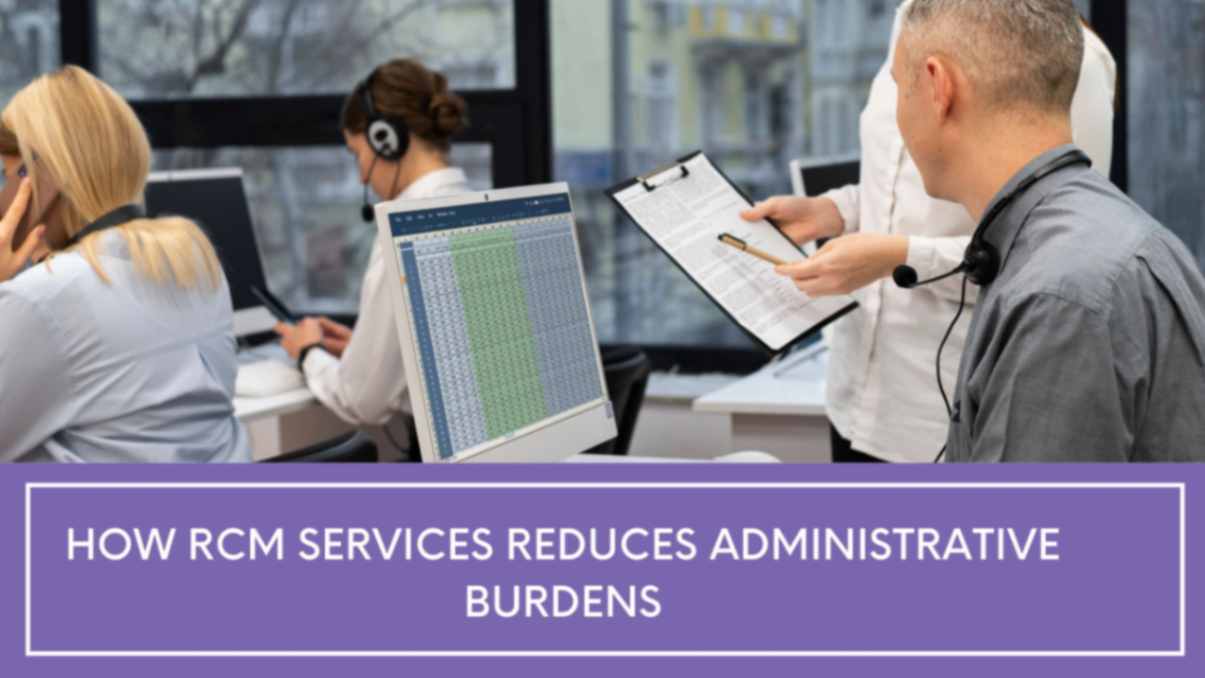How RCM Services Reduces Administrative Burdens
In the healthcare sector, managing RCM services reduces administrative burdens effectively can be complex and resource-intensive. RCM is vital. It pays providers on time, reduces denials, and keeps them healthy. Yet, administrative tasks associated with RCM can drain resources and overwhelm healthcare professionals. Practices and billing firms can find a solid answer to their issues with RCM automation. They enable the streamlining of operations. Revenue Cycle automation systems reduce human error. They help billing organizations and practices free up employees for more valuable work. Let’s explore key automation tools. They can ease admin work in RCM. This will boost efficiency and revenue.
Table of Contents
Understanding RCM and its Challenges:
Healthcare Revenue Cycle Management includes all aspects of a patient’s financial relationship with a healthcare provider. Right from scheduling and registration to claim submission, payment processing, and collections. In RCM, key tasks are data entry, verifying eligibility, prior auth, and claims. Also, follow up on payments and denials. These tasks must be precise, diligent, and prompt. It will prevent payment delays, claim denials, and compliance issues.
Despite their significance, these chores can frequently become monotonous and time-consuming. This leads to a high probability of inaccuracy, inefficiency, and burnout. According to reports, administrative processes tie up to 30% of healthcare costs. Healthcare organizations are adopting RCM automation to ease these burdens and optimize workflows.
Key RCM Automation Solutions to Reduce Administrative Burden
1.Automated Patient Registration and Eligibility Verification
One of the earliest points in the revenue cycle is patient registration. It includes verifying their eligibility. Registration errors, including incorrect patient data or outdated insurance details, cause delays. This, in turn, opens the door to claim denials. Automating these processes enables real-time verification of insurance eligibility. This reduces the risk of error and accelerates claim processing.
With automated solutions, practices can:
- Validate patient insurance information instantly.
- Check co-pays, deductibles, and other information before the appointment.
- Cut the need for tedious manual reviews to reduce errors.
RCM automation tools can verify eligibility by connecting directly to payers’ databases. Instantly, these tools flag discrepancies in patient information or coverage. Notifications of potential issues are sent to front-desk staff in advance. This early intervention reduces rejected claims and boosts clean claim rates.
2.Streamlined Prior Authorization
Prior authorization (PA) is a significant bottleneck in many revenue cycles. Manually obtaining prior authorization can significantly delay patient care. This process is labor-intensive and requires coordination with payers. It involves repeated follow-ups and dealing with paperwork. Automating prior authorization simplifies this process using AI-driven algorithms. It identifies PA requirements, submits requests, and tracks approvals.
Benefits of PA automation include:
- Reduced time spent on manual authorization tasks.
- Enhanced compliance with payer requirements.
- Accelerated care delivery without delays from pending authorizations.
Automated PA systems are often integrated with EHRs and RCM software. This integration allows clinical and administrative teams to work more seamlessly. With data pulled directly from patient charts, the PA process is streamlined. This ensures faster approvals and reduces the administrative burden on staff.
3.Automated Charge Capture and Coding
Accurate coding is critical to successful claim submission. This is because errors in coding often lead to claim denials or delays in payment. Traditional coding involves sifting through patient records to apply the correct codes. This task is slow and prone to errors.
Charge capture automation uses machine learning and NLP. They help it to process and capture charges with precision and effectiveness:
- Extract relevant information from clinical notes and convert it into billable codes.
- Flag discrepancies between clinical documentation and selected codes.
- Reduce the need for manual intervention in coding, minimizing errors.
This automation accelerates the coding process. It also ensures compliance with coding guidelines. Thus, reducing the likelihood of claim denials. Integrating charge capture with EHR systems lets providers document services more easily. This allows them to bill services with precision, which leads to improved claims.
4.Claims Management Automation
Claims management encompasses everything from claim generation to submission, tracking, and denial resolution. Automation can have the most immediate impact here. It can address multiple administrative tasks that need a lot of manual effort.
Automated claims management solutions help in:
- Automatically generating claims from patient records and EHRs.
- Submitting claims directly to payers with minimal manual intervention.
- Tracking claims status in real-time, flagging issues, and initiating corrections as needed.
Advanced claim management systems can detect claim discrepancies and fix them before submission. This helps maintain high first-pass rates. Automated tools also handle repetitive follow-up tasks. They reach out to payers and check claim statuses without human involvement. This speeds up the payment process and significantly reduces administrative burdens.
5.Denial Management Automation
Handling claim denials is one of the most resource-intensive parts of RCM. Fixing denied claims takes up time and resources. Manual identification, correction, and resubmission pull staff away from critical revenue cycle work. Streamlining this process could boost efficiency and focus.
Denial management automation offers:
- Identification and analysis of common denial reasons.
- Automated reprocessing of denials with built-in learning to prevent similar errors.
- Reporting tools can provide insights into denial patterns. Practices can make data-driven improvements based on these insights.
These solutions use machine learning to identify recurring issues. They flag denials that can be prevented in the future. Automated denial management tools are helpful for organizations dealing with high claim volumes. They reduce the time spent on reworking claims, and they help prevent revenue leakage.
6.Payment Posting and Patient Collections
In a manual setting, payment posting requires staff to review EOBs. They must match payments to claims and reconcile any discrepancies. Automated payment posting tools expedite this process by:
- Automatically reading and posting payments from EOBs and remittance advice.
- Reconciling payments with claims and updating patient accounts in real-time.
- Flagging any mismatches or short payments for review.
Furthermore, RCM automation extends to patient collections. Automated patient billing solutions can generate patient statements. They can also send reminders via text or email. Additionally, these solutions offer secure payment options online. This creates a smoother experience for patients. It also improves the likelihood of timely payments. As a result, it helps reduce the administrative burden on billing staff.
7.Data Analytics and Reporting
Automation in RCM goes beyond transactional processes. It includes a data analytics tool. This helps track revenue cycle performance and find areas to improve. With automated analytics, practices can:
- Generate reports on KPIs. These include denial rates, average days in A/R, and clean claim rates.
- Look for trends that may signal issues. For example, an increase in denials from specific payers.
- Make informed decisions to further optimize the revenue cycle.
Analytics-driven insights empower RCM managers to make proactive adjustments to workflows. It lets them fix revenue risks before they hurt profits. Practices can monitor performance metrics to ensure automation works. It must improve efficiency and financial health.
Benefits of RCM Automation
The implementation of RCM automation offers significant benefits:
- Reduced Labor Costs: Automation cuts the need for manual work. It eliminates data entry, claim processing, and follow-ups. Staff can then focus on higher-value tasks with minimal interruptions.
- Faster Reimbursements: Streamlined claim submission and tracking accelerate payments, enhancing cash flow.
- Improved Compliance: Automated systems reduce errors. They maintain adherence to payer rules and ensure regulatory compliance.
- Scalability: As patient volume grows, automated RCM processes can scale. They won’t need a proportional rise in admin staff.
- Patient Satisfaction: Practices can improve patient satisfaction and trust. They can do this by minimizing delays and billing errors. This will create a smoother experience for patients.
How Practolytics Helps Healthcare Practices with RCM Automation
At Practolytics, we use cutting-edge RCM automation solutions. This helps healthcare providers reduce administrative burdens, maximize revenue, and improve efficiency. We integrate advanced automation tools with our comprehensive RCM services. It allows us to provide revenue cycle support that meets each client’s needs.
Our automation solutions help practices focus on patient care. They handle eligibility verification, claims management, and denial resolution for us. Practolytics RCM services are designed to drive efficiency. They help reduce costs. Our services streamline workflows. We are the ideal partner for healthcare organizations. They seek to optimize their revenue cycle.
Conclusion:
RCM automation is now essential for healthcare practices to stay competitive. It cuts administrative work, letting providers focus on patients. This improves revenue and streamlines operations. With the right tools, practices can create a more efficient, sustainable revenue cycle. This supports long-term growth and success.
If your medical practice is prepared to leverage the capabilities of RCM automation, Practolytics is on hand to guide you. Reach out to us to explore our RCM offerings and take the initial step towards a more productive revenue cycle.
ALSO READ – Essential Tips for Error-Free Orthopedic Billing and Coding: Boost Your Practice’s Financial Health
Talk to Medical Billing Expert Today — Get a Free Demo Now!






